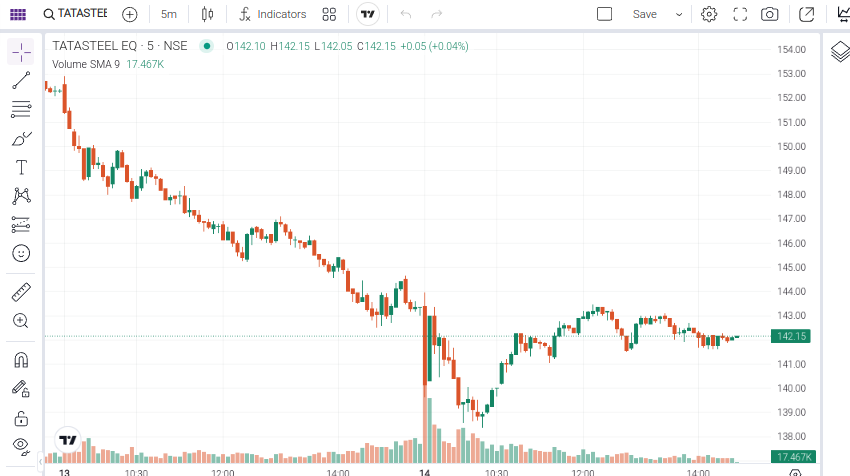A Stock Market is a physical as well as a virtual market that allows people and institutions to invest and trade different instruments across different exchanges to make a profit. However, profit and loss solely depend on one’s market analysis and positions. Companies enlist with various exchanges to raise capital in the form of Equity for running their business operations. Investors and traders trade on their stocks to make profits.

Stock Market in India dates back to 1875 when the Bombay Stock Exchange (BSE) was established. The National Stock Exchange (NSE) was established in 1992. The present-day stock market allows you to invest and trade in various segments, including Equity, F&O, Commodity, and Currency.

The Stock market has a significant impact on the economy of a country. The same holds true for India. It helps individuals create personal wealth. It helps companies raise capital through IPO and Equity without putting an excess burden on banks as in business loans. The stock market plays a vital role in improving the Gross Domestic Product (GDP) by encouraging investments. Hence, it wouldn’t be wrong to say that the stock market even impacts the lives of non-investors. Most importantly, the stock market is seen as an essential indicator of a country’s economy.
History of the Indian Stock Market
As already pointed out, BSE was established in 1875, and NSE was established in 1992. In the early days, investing in the Indian stock market wasn’t as easy as today. All price-related speculations used to be based on limited news that investors had access to. Back then, only a small part of the Indian population would actually invest in the stock market.
Trading was not a familiar term back in those times. 1992 was a crucial year in the history of the Indian stock market. FIIs entered the Indian stock market in 1992, and coincidently, the biggest stock market scam, the Harshad Mehta scam, happened in the same year.
The SEBI determines all the important decisions and policies of the Indian Stock Market. SEBI stands for Securities and Exchange Board of India. Every broker wanting to participate in the Indian stock market must be registered with SEBI and abide by its rules. 2000 was another turning point for Indian Investors as Geojit Securities introduced internet trading in India for the first time. The idea was both exciting and intimidating back then since investors feared losing money out of technical glitches.
Sharekhan is one of the leading online brokers in India, which also started in 2000. Since then, many brokers have been working on their trading platforms. However, Zerodha revolutionized online trading in all aspects by providing Indians with a simple yet reliable platform for trading and investing. Ever since Zerodha came up, there has been a steady increase in the number of traders and investors in India. Further, many more reliable online trading platforms have emerged in recent years.

How the Indian Stock Market Works
Indian Stock Market allows investors and traders to invest and trade in IPOs, Equity, Mutual Funds, F&O, commodities, and currency. Since most people start with stocks, it’s essential to understand the types of stocks:
- Large-cap stocks are stocks with a market capitalization of ₹20000 crore or more
- Mid-cap stocks are stocks with a market capitalization of more than ₹5000 crores but less than ₹20000 crore
- Small-cap stocks are stocks with a market capitalization of less than ₹5000 crore
As far as the market participants are concerned, the stock market consists of a regulator, brokers, retail investors, retail traders, and institutional investors. SEBI is the regulator of the Indian stock market. Platforms like Zerodha, Angel Broking, Kotak Securities, and Upstox are the brokers. Retail investors and traders invest and trade in the market for dividends or profits. However, they can’t move or control the price.
On the other hand, Institutional investors are Foreign or Domestic institutions that can move the price in the market with their high-volume orders. These institutions include Mutual Fund houses, Banks, Insurance companies, and Pension Funds.
Next, it’s important to walk you through the benefits and risks of investing in the Indian stock market. Investing in the market, you can earn from capital appreciation and dividends when a company does fundamentally well. However, if a company struggles fundamentally, you have a higher chance of making losses. Another worst-case scenario is increased market volatility, also known as panic selling.
How to Invest in the Indian Stock Market
If you are planning to enter the Indian Stock Market, you must start with a plan. However, before that, you will need to break out of the notion that one can become rich overnight by Investing or trading in the stock market. Before you start investing and trading, you must know the benefits and risks involved in investing.
Further, you will meet many people who will try to discourage you from entering the stock market, calling it a place of pure gambling, with their limited perception of the stock market. You must never disclose your plan of entering the stock market to such people.
I am sure you are wondering how to start investing in the stock market, and it’s actually not difficult anymore. To begin your investing and trading journey, you must open an online trading account with any reliable trading platform. Zerodha, Upstox, Angel One, and Dhan are some of the best trading platforms. The process will essentially require you to complete your KYC and link your bank account for deposits and withdrawals.
Once your trading account is ready, you can invest and trade in IPOs, Equity, Mutual Funds, F&O, Commodity, and Currency. While an investment usually involves taking a position with a long-term perspective, trading involves squaring off a position on the same day as in Day Trading or squaring off a position on the next day as in BTST. Besides, a trade can last up to a week, as in Swing Trading.
Even though you have a lot of financial instruments to invest in and trade in the market, it’s always wise to start with Equity first. You must learn essential basics, technical analysis, and various trading and investing styles for the first year.

Besides, you must understand which type of trading or investing you are most comfortable with. The starting one to two years is really crucial for every trader and investor. Hence, you must keep your capital as low as possible for the first two years.
Winning and losing is a part of the game. While we don’t have any control over profits, we do have control over our losses to a large extent. This is where the Risk & Reward ratio comes into play. The Risk & Reward ratio is a part of Money Management.
You must determine the risk you are most comfortable with for your desired reward. After you do this, you can enter a position based on your technical analysis. You can further strengthen it with proper position sizing.
You must do a proper technical analysis of a stock before investing and by rule of thumb, you must invest in a stock when it's at its low. You can determine this by using an indicator like EMA or price-action.

The best part is you don't have to use Stop Loss in investments. However, you will definitely need a lot of patience even when you think the price of the stock is declining. A long term perspective is much needed in investment. Experts advise to invest in a good stock and forget it for 5 to 10 years.
Conclusion
I have provided you with good clarity on the Indian stock market in this post. I have explained the history of the Indian market and offered a roadmap on how to step into the Indian stock market and take your first financial position. Besides, I have informed you of the possible risks and benefits of investing and trading in the stock market. You can start your trading and investing journey with much confidence now.

